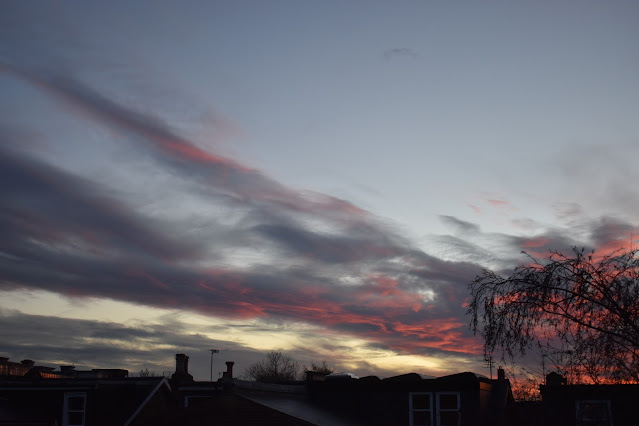Sunday 30 January 2022
Saturday 29 January 2022
... and the View from the Pratchett Estate...
From The Guardian 27/1/2022
Terry Pratchett’s estate has authorised Jack Monroe to use the “Vimes Boots Index” as the name of her new price index, which is intended to document the “insidiously creeping prices” of basic food products.
The author’s daughter, writer Rhianna Pratchett, said her
father would have been proud to see his work used in this way by the anti-poverty
campaigner. Monroe was prompted to create her index after inflation jumped to
5.4% last week, and she found herself “infuriate[d]” that the index (the
consumer price index or CPI) used for this calculation “grossly underestimates
the real cost of inflation as it happens to people with the least”. She laid
out how the prices of “value” product ranges in supermarkets had soared over
the last decade – rice in her local supermarket had increased in price from 45p
for a kilogram bag last year, to £1 for 500g, a 344% increase – and how the
number of value products has shrunk. She was soon working with economists,
charities and analysts to compile her own index.
“One,” she wrote in the Observer, “that will document the
disappearance of the budget lines and the insidiously creeping prices of the
most basic versions of essential items at the supermarket” and “serve as an
irrefutable snapshot of the reality experienced by millions of people”.
In a tweet on Wednesday, Monroe announced that the index is
already starting to make a difference, as the Office for National Statistics
has admitted that “one inflation rate doesn’t fit all”. She wrote: “Delighted
to be able to tell you that the @ONS have just announced that they are going to
be changing the way they collect and report on the cost of food prices and
inflation to take into consideration a wider range of income levels and
household circumstances”, using the hashtag #VimesBootsIndex.
The index, Monroe said, is named in honour of Pratchett’s
creation Sam Vimes, who in the Discworld novel Men at Arms lays out the “Sam
Vimes ‘Boots’ theory of socio-economic unfairness”.
“The reason that the rich were so rich, Vimes reasoned, was
because they managed to spend less money,” wrote Pratchett. “Take boots, for
example. He earned thirty-eight dollars a month plus allowances. A really good
pair of leather boots cost fifty dollars. But an affordable pair of boots,
which were sort of okay for a season or two and then leaked like hell when the
cardboard gave out, cost about ten dollars. Those were the kind of boots Vimes
always bought, and wore until the soles were so thin that he could tell where
he was in Ankh-Morpork on a foggy night by the feel of the cobbles. But the
thing was that good boots lasted for years and years. A man who could afford
fifty dollars had a pair of boots that’d still be keeping his feet dry in ten
years’ time, while a poor man who could only afford cheap boots would have
spent a hundred dollars on boots in the same time and would still have wet
feet.”
The Pratchett estate has authorised the use of the name,
tweeting its own Pratchett quote in support of Monroe’s campaign. “Sometimes
it’s better to light a flamethrower than curse the darkness,” wrote the late
Discworld author in Men at Arms.
Rhianna Pratchett said: “My father used his anger about
inequality, classism, xenophobia and bigotry to help power the moral core of
his work. One of his most famous lightning-rods for this was Commander Vimes of
the Ankh-Morpork City Watch - a cynical, but likable, man who attempts to
better himself whilst railing against the injustices around him. Some of which
he’s had a hand in perpetrating in the past.
Thursday 27 January 2022
Wednesday 26 January 2022
The CPI versus the Vimes Boot Index
Monday 24 January 2022
Saturday 22 January 2022
Wednesday 19 January 2022
Tuesday 18 January 2022
Not Larkin About
(Sandra Bond, After Philip Larkin)
Wednesday 12 January 2022
Sunday 9 January 2022
Wednesday 5 January 2022
Space Probes I
A few months ago, the regular email I get from New Scientist
magazine mentioned the then-upcoming launch of the Lucy space probe. This mission is designed to explore the Trojan
asteroids in the orbit of Jupiter.
I thought this interesting, and watched the launch online in
October, on NASA TV, which itself a very
strange channel: there’s a sense that people who just want to geek out about
space and engineering are perpetually holding themselves back, probably to stick
to the corporate messages.
The Lucy mission has a complex trajectory – this is what the
NASA site said in late November:
The spacecraft is traveling at roughly 67,000 mph (108,000
kph) on a trajectory that will orbit the Sun and bring it back toward Earth in
October 2022 for the spacecraft’s first gravity assist. That manoeuvre will
accelerate and direct Lucy’s trajectory beyond the orbit of Mars. The
spacecraft will then swing back toward Earth for another gravity assist in
2024, which will propel Lucy toward the Donaldjohanson asteroid – located
within the solar system’s main asteroid belt – in 2025.
Lucy will then journey toward its first Trojan asteroid
encounter in the swarm ahead of Jupiter for a 2027 arrival. After completing
its first four targeted flybys, the spacecraft will travel back to Earth for a
third gravity boost in 2031, which will catapult it to the trailing swarm of
Trojans for a 2033 encounter.[1]
It’s a complicated series of manoeuvres, and I suspect the
looping curves shown on the site don’t really do it justice. Lucy will carry a number of instruments,
including an infrared imaging spectrometer, a thermal emission spectrometer and
a range of cameras.
This mission captured my imagination, in part because of the
number of science fiction stories I’ve read set on the asteroids. Admittedly, these were more often about
mining the asteroid belt between Mars and Jupiter, but still there were stories
set among the Trojans.
Later, there was if anything a more SFNal mission launch: Dart,
which will attempt to nudge a large space rock, as part of experiments of
planetary defence systems. The ‘Double
Asteroid Redirection Test’:
is a planetary defence-driven test of technologies for preventing an impact
of Earth by a hazardous asteroid. DART will be the first demonstration of the
kinetic impactor technique to change the motion of an asteroid in space.[2]
This is more than a little worrying, given the number of
stories there are out there, where such a mission goes wrong and wreaks
catastrophe on the Earth. Still, I’m
sure they’ve though of all that?
Following the launch of Dart, on Christmas Eve, came the
much-delayed launch of the James Webb Telescope is due. Webb, once deployed, will primarily look in
the infrared spectrum, and if successful will tell us a lot more about the
earliest era of the Universe.
Which got me thinking: given this triumvirate of interesting
launches in the last three months of 2021, what is already up there, and still
working?
There are many other space-borne telescopes, such as the Chandra
X-Ray Observatory, launched in 1999 and still contributing to research on
black holes, dark matter and dark energy. Chandra has four mirrors focusing
X-rays. Images and spectra can be
captured.
Operating well beyond its expected lifetime, NASA's Advanced
Composition Explorer (ACE), launched in 1997, still sits at the Earth-Sun
L1 point to collect and analyse particles of solar, interplanetary,
interstellar and galactic origins. ACE
continues to provide space weather reports and warnings of geomagnetic storms
that can disrupt communications on Earth and harm astronauts in space.
More recently, again
just last December, a SpaceX Falcon 9 rocket launched NASA’s Imaging X-ray
Polarimetry Explorer (IXPE) satellite. The IXPE is the first satellite
capable of measuring the polarization of X-rays that come from cosmic sources,
such as black holes and neutron stars.
The satellite has three telescopes that can track and measure the
direction, arrival time, energy, and polarization of light.
There’s also the Parker Solar Probe, which in
November completed its 10th close approach to the Sun, coming within 5.3
million miles of the solar surface.
It isn’t all about NASA.
BepiColombo is Europe's first mission to Mercury. Launched on 20
October 2018, it is on a seven-year journey and should arrive at Mercury in
late 2025. It has already had a close
flyby of the planet, at 199 km in early October 2021, when it began sampling
the magnetic and particle environment around the planet. The mission comprises two spacecraft: the
Mercury Planetary Orbiter (MPO) and the Mercury Magnetospheric Orbiter (Mio).
BepiColombo is a joint mission between ESA and the Japan Aerospace Exploration
Agency (JAXA).
More to follow























